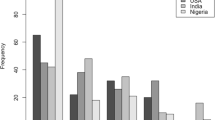Abstract
According to Downs’ spatial model of electoral competition, in two-party systems, political parties move closer to the median voter’s preferences, while in multiparty democracies, party platforms target their own electorate. This model has been used to predict parties’ policy positions, but never to explain their salience choices. Based on data from political manifestos and public opinion in 23 European countries from 2004 to 2012, we show that the Downsian model can be applied to salience strategies when issue attention is different among left-wing and right-wing voters. In line with the spatial theory, parties choose to place emphasis on different issues in their manifestos depending on the importance attached to each of these issues by either the median voter or their partisan voters, depending on their size and the characteristics of the party system.


Similar content being viewed by others
Notes
Political manifestos are more appropriate than public policies to test the spatial model for two reasons. First, manifestos are more manipulable, i.e., it is easier to adjust platforms than policies in response to changes in public opinion. Second, manifestos are equally available for each citizen at the national level, whereas policies may be targeted at specific interest groups and therefore lack visibility for the whole public. This choice is far from new: an abundant literature has already tested the spatial model with political manifestos.
The list includes the following issues: economic situation, crime, inflation, taxation, unemployment, terrorism, foreign affairs, housing, immigration, healthcare system, educational system, pensions, environment, and energy.
In some cases, we collected data on public opinion only 4 months before the election (Spain, 2004; Poland, 2007; Denmark, 2005; Portugal, 2005) because the desirable slot was not available.
On the manifestos database, some of them are easily traceable: Environment is coded 501 (Environmental Protection); Crime: 605 (Law and Order); Education: 506 (Education Expansion); and 507 (Education Limitation); Immigration: 607 and 608 (Multiculturalism positive and negative). Healthcare and pensions are included in the general categories 504 and 505 (Welfare State Expansion and Limitation). Foreign Policy includes all codes in Domain 1 (External Relations), except those about the European Union (108 and 110). Finally, the Economy includes 401 (Free enterprise), 402 (Incentives), 403 (Market regulation), 404 (Economic planning), 406 and 407 (protectionism positive and negative), 408 (economic goals), 409 (Keynesian Demand Management), 410 (productivity), 412 (Controlled economy), and 413 (Nationalization).
Note that this operationalization implies taking 13 small parties out of the analysis due to missing information.
Results with different thresholds are provided by the authors on request.
References
Adams, J., and Z. Somer-Topcu. 2009. Moderate now, win votes later: The electoral consequences of parties’ policy shifts in 25 postwar democracies. Journal of Politics 71 (2): 678–692.
Adams, J., M. Clark, L. Ezrow, and G. Glasgow. 2006. Are Niche Parties fundamentally different from mainstream parties? The causes and the electoral consequences of Western European Parties’ Policy Shifts, 1976–1998. American Journal of Political Science 50 (3): 513–529.
Andrews, J., and J. Money. 2009. The spatial structure of party competition: Party dispersion within a finite policy space. British Journal of Political Science 39 (4): 805–824.
Budge, I., and D.J. Farlie. 1983. Explaining and predicting elections. Issue effects and party strategies in twenty-three democracies. London: Allen & Unwin.
Budge, I., et al. (eds.). 2001. Mapping policy preferences. Oxford: Oxford University Press.
Calvo, E., and T. Hellwig. 2011. Centripetal and centrifugal incentives under different electoral systems. American Journal of Political Science 55 (1): 27–41.
Cox, G.W. 1990. Centripetal and centrifugal incentives in electoral systems. American Journal of Political Science 34 (4): 903–935.
Curini, L., and A. Hino. 2012. Missing links in party-system polarization: How institutions and voters matter. Journal of Politics 74 (2): 460–473.
De Sio, L., and T. Weber. 2014. Issue yield: A model of party strategy in multidimensional space. American Political Science Review 108 (4): 870–885.
Dolezal, M., L. Ennser-Jedenastik, W.C. Muller, and A.K. Winkler. 2014. How parties compete for votes: A test of saliency theory. European Journal of Political Research 53 (1): 57–76.
Dow, J.K. 2001. A comparative spatial analysis of majoritarian and proportional elections. Electoral Studies 20: 109–125.
Dow, J.K. 2011. Party-system extremism in majoritarian and proportional electoral systems. British Journal of Political Science 41 (2): 341–361.
Downs, A. 1957. An economic theory of democracy. New York: Harper and Brothers.
Elias, A., E. Szöcsik, and C.I. Zuber. 2015. Position, selective emphasis and framing: How parties deal with a second dimension in competition. Party Politics 21 (6): 839–850.
Ezrow, L. 2008. Parties’ policy programmes and the dog that didn’t bark: No evidence that proportional systems promote extreme party positioning. British Journal of Political Science 38 (3): 479–497.
Ezrow, L. 2011. Electoral systems and party responsiveness. In Political economy of institutions, democracy and voting, ed. N. Schofield, and G. Caballero, 303–325. Berlin: Springer.
Ezrow, L., C. De Vries, M. Steenbergen, and E. Edwards. 2011. Mean voter representation and partisan constituency representation: Do parties respond to the mean voter position or to their supporters? Party Politics 17 (3): 275–301.
Green, J. 2007. When voters and parties agree: Valence issues and party competition. Political Studies 55 (3): 629–655.
Green, J., and S.B. Hobolt. 2008. Owning the issue agenda: Party strategies and vote choices in British elections. Electoral Studies 27 (3): 460–476.
Grofman, B. 2004. Downs and two-party convergence. Annual Review of Political Science 7: 25–46.
Guinaudeau, I., and P. Persico. 2014. What is issue competition? Conflict, consensus and issue ownership in party competition. Journal of Elections, Public Opinion & Parties 24 (3): 312–333.
Laakso, M., and R. Taagepera. 1979. Effective number of parties: A measure with application to Western Europe. Comparative Political Studies 12 (1): 3–27.
Meguid, B.M. 2005. Competition between unequals: The role of mainstream party strategy in niche party success. American Political Science Review 99 (3): 347–359.
Meguid, B.M. 2008. Party competition between unequals: Strategies and electoral fortunes in Western Europe. Cambridge: Cambridge University Press.
Meyer, T.M., and M. Wagner. 2013. Mainstream or niche? Vote-seeking incentives and the programmatic strategies of political parties. Comparative Political Studies 46 (10): 1246–1272.
Petrocik, J.R. 1996. Issue ownership in presidential elections, with a 1980 case study. American Journal of Political Science 40 (3): 825–850.
Rovny, J. 2012. Who emphasizes and who blurs? Party strategies in multidimensional competition. European Union Politics 13 (2): 269–292.
Stokes, D. 1963. Spatial models of party competition. American Political Science Review 57 (2): 368–377.
Theriault, S.M. 2006. Party polarization in the US Congress: Member replacement and member adaptation. Party Politics 12: 483.
van Heck, S. 2016. Appealing broadly or narrowing down? The impact of government experience and party organization on the scope of parties’ issue agendas. Party Politics. doi:10.1177/1354068816657374.
Wagner, M. 2012. When do parties emphasize extreme positions? How strategic incentives for policy differentiation influence issue importance. European Journal of Political Research 51: 64–88.
Wagner, M., and T.M. Meyer. 2014. Which issues do parties emphasise? Salience strategies and party organisation in multiparty systems. West European Politics 37 (5): 1019–1045.
Wlezien, C. 2005. On the salience of political issues: The problem with ‘most important problem’. Electoral Studies 24 (4): 555–579.
Acknowledgements
The authors thank Isabelle Guinaudeau, Sylvain Brouard and Anna Jeannesson for their insightful comments.
Author information
Authors and Affiliations
Corresponding author
Appendices
Appendix 1
Appendix 2
Rights and permissions
About this article
Cite this article
Magni-Berton, R., Panel, S. Manifestos and public opinion: testing the relevance of spatial models to explain salience choices. Comp Eur Polit 16, 783–804 (2018). https://doi.org/10.1057/s41295-017-0101-2
Published:
Issue Date:
DOI: https://doi.org/10.1057/s41295-017-0101-2




